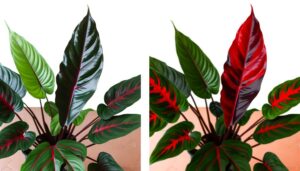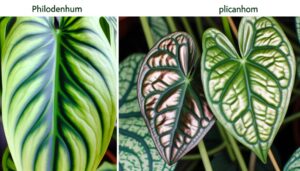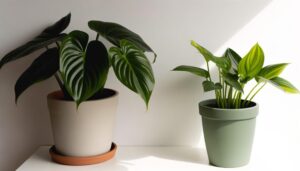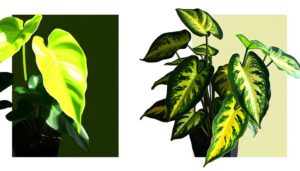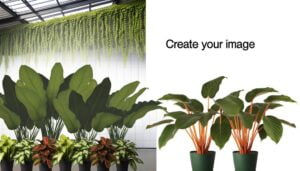Philodendron Atabapoense Vs Spiritus Sancti: Key Differences
Philodendron Atabapoense and Philodendron Spiritus Sancti, while both belonging to the same genus, showcase significant differences in origin, morphology, and growth requirements. P.
Atabapoense is native to Venezuela, thriving in humid, shaded environments with lanceolate, dark green leaves and burgundy undersides. In contrast, P.
Spiritus Sancti hails from Brazil’s Atlantic Forest with broad, ovate deep green leaves, preferring high humidity and consistent rainfall. P.
Atabapoense displays a climbing habit needing support structures, whereas P. Spiritus Sancti grows epiphytically, attaching to tree trunks.
Further detailing their unique ecological adaptations and horticultural needs reveals more intricate aspects.
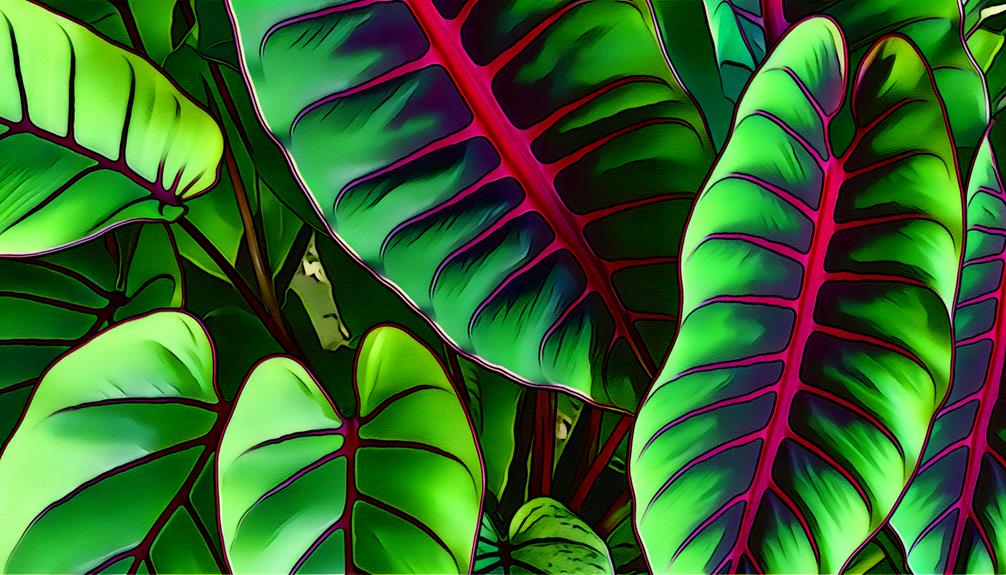
Comparison of Philodendron Atabapoense and Philodendron Spiritus Sancti
| Characteristic | Philodendron Atabapoense | Philodendron Spiritus Sancti |
|---|---|---|
| Leaf Shape | Arrow-like, violin/cello shaped | Heart-shaped with rounded lobes |
| Leaf Color | Dark green with purple-burgundy undersides | Pale green with black markings along veins |
| Rarity | Less common, but more available | Extremely rare and endangered |
| Native Region | Amazon rainforest, particularly Venezuela | Small region in Ecuador and Peru |
| Subgenus | Not specified in results | Meconostigma |
| Growth Rate | Not specified in results | Slow grower |
| Price Range | More affordable | Very expensive ($100-$500 for small plants) |
| Conservation Status | Not specified in results | Endangered |
| Humidity Requirements | Not specified in results | Very high (80-100%) |
Origins and Natural Habitat
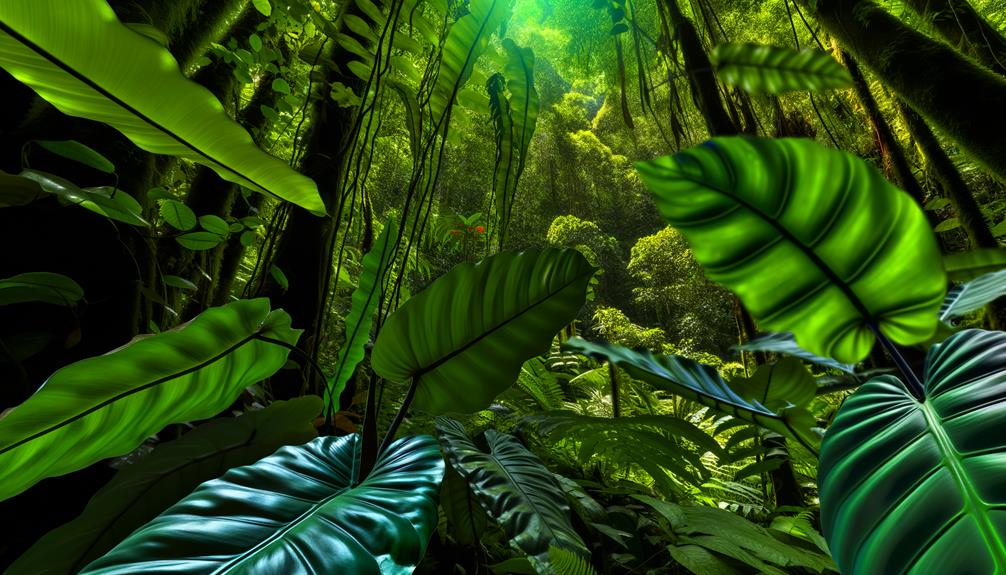
While both Philodendron Atabapoense and Philodendron Spiritus Sancti belong to the Araceae family, their origins and natural habitats exhibit distinct ecological preferences and geographical distributions.
Philodendron Atabapoense is native to the lush tropical rainforests of Venezuela, particularly thriving along the Orinoco River basin. This species favors humid, shaded environments with rich, well-drained soils.
In contrast, Philodendron Spiritus Sancti is endemic to the Atlantic Forest in Brazil, specifically within the Espirito Santo region. This area is characterized by high humidity and consistent rainfall, providing an ideal microclimate for its growth.
The limited geographic range of P. Spiritus Sancti contributes to its rarity and conservation concerns, whereas P. Atabapoense benefits from a comparatively broader distribution in its native habitat.
Leaf Shape and Color
Philodendron Atabapoense exhibits elongated, lanceolate leaves with a distinctively narrow width and pronounced central vein.
Whereas Philodendron Spiritus Sancti presents broader, more ovate leaves with a subtle undulating margin.
Concerning coloration, Atabapoense’s foliage typically features a dark green adaxial surface contrasted by a burgundy abaxial side,
while Spiritus Sancti displays a uniform deep green hue on both leaf surfaces.
These morphological and color distinctions are crucial for precise species identification and comprehending their adaptive strategies within their respective habitats.
Leaf Morphology Differences
Examining the leaf morphology of Philodendron atabapoense and Philodendron spiritus-sancti reveals distinct differences in both shape and color that are critical for accurate botanical identification.
Philodendron atabapoense exhibits elongated, lanceolate leaves with a pronounced midrib and acute apex. The adaxial (upper) surface is a rich green, while the abaxial (lower) surface is characterized by a reddish hue.
In contrast, Philodendron spiritus-sancti presents elongated, sagittate (arrow-shaped) leaves with a more pronounced lobed base and a tapering tip. Its adaxial surface is a deep, glossy green, whereas the abaxial surface is a lighter green.
These morphological distinctions are essential for differentiating between these two species, especially in botanical studies and cultivation practices.
Color Variations
The color differences between Philodendron atabapoense and Philodendron spiritus-sancti are striking. The former shows a sharp contrast with its dark green upper surface and reddish underside, while the latter displays a deep, shiny green upper surface paired with a lighter green lower surface.
Philodendron atabapoense’s upper surface is non-glossy, enhancing the sharpness with its vibrant reddish underside. Conversely, Philodendron spiritus-sancti presents a consistent, shiny texture on the upper side, which shifts subtly to a lighter green below.
This comparison highlights the grace of Spiritus Sancti. Such unique color differences not only add to their individual visual appeal but also aid in their recognition and categorization within the Philodendron genus.
Growth Patterns
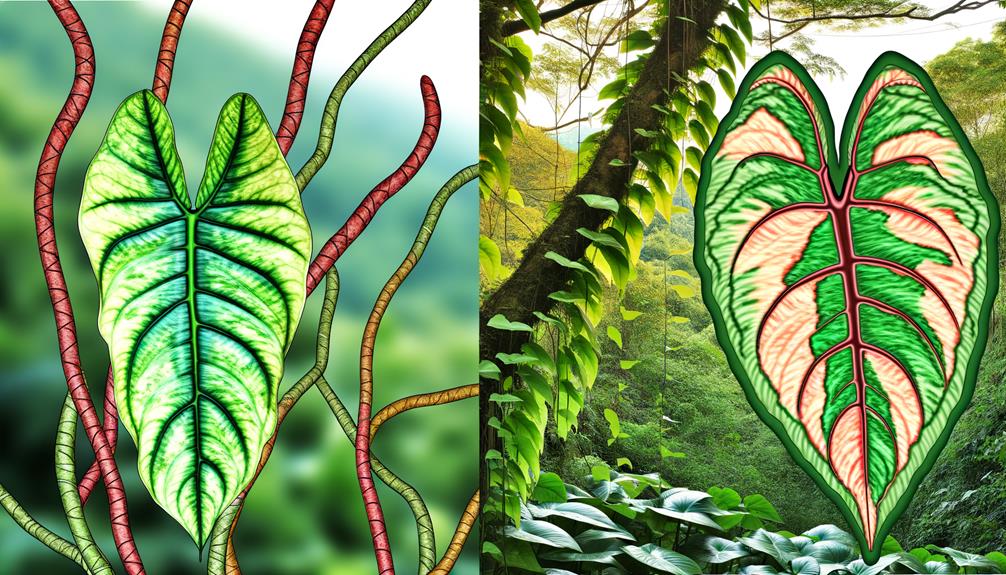
Distinctive growth patterns characterize both Philodendron Atabapoense and Spiritus Sancti. Each species exhibits unique leaf morphology and stem development under varying environmental conditions.
Philodendron Atabapoense features elongated, lanceolate leaves with a distinct reddish hue on the undersides. Its stems develop a climbing habit, often requiring support structures for optimal vertical growth.
In contrast, Philodendron Spiritus Sancti showcases elongated, arrow-shaped leaves with pronounced midribs. This species propagates through epiphytic growth, attaching itself to tree trunks in its native habitat.
These morphological differences are adaptations to their specific ecological niches, influencing their respective cultivation requirements. Comparative analysis reveals that while both species thrive in tropical climates, their growth forms necessitate tailored horticultural practices to effectively simulate natural conditions.
Light and Water Needs
Examining the light and water needs of Philodendron Atabapoense and Spiritus Sancti reveals distinct preferences critical for best growth.
Philodendron Atabapoense thrives under bright, indirect light conditions, whereas Spiritus Sancti demonstrates a higher tolerance for lower light environments.
Additionally, watering frequency for Philodendron Atabapoense necessitates consistent moisture without waterlogging, contrasting with the Spiritus Sancti’s preference for a more controlled watering regimen that allows for slight drying between waterings.
Optimal Light Conditions
Both Philodendron Atabapoense and Spiritus Sancti thrive in environments that provide bright, indirect light. Subtle differences in their light tolerance can influence their overall health and growth rate.
Philodendron Atabapoense demonstrates a higher tolerance for lower light conditions compared to Spiritus Sancti, which requires consistently bright light for best growth.
For ideal light conditions, consider the following:
- Light Intensity: Ensure exposure to bright, filtered light to mimic their natural understory habitat.
- Duration: Maintain approximately 10-12 hours of light daily, replicating tropical day lengths.
- Light Source: Utilize sheer curtains or light-diffusing materials to prevent direct sunlight, which can cause leaf burn.
Adhering to these guidelines promotes robust growth and vibrant foliage in both species.
Watering Frequency Requirements
Understanding the watering frequency requirements of Philodendron Atabapoense and Spiritus Sancti is essential, as both species demand consistent moisture levels but exhibit varying sensitivity to overwatering and drought conditions.
Philodendron Atabapoense prefers slightly moist soil and can tolerate brief periods of dryness, whereas Spiritus Sancti is more sensitive and requires consistently moist soil without waterlogging. Overwatering can lead to root rot in both, but Spiritus Sancti is particularly susceptible.
| Aspect | Philodendron Atabapoense | Spiritus Sancti |
|---|---|---|
| Moisture Preference | Slightly moist | Consistently moist |
| Drought Tolerance | Moderate | Low |
| Overwatering Sensitivity | High | Very High |
| Ideal Watering Interval | Every 7-10 days | Every 5-7 days |
| Soil Type | Well-draining | Well-draining with high organic matter |
Soil and Fertilization
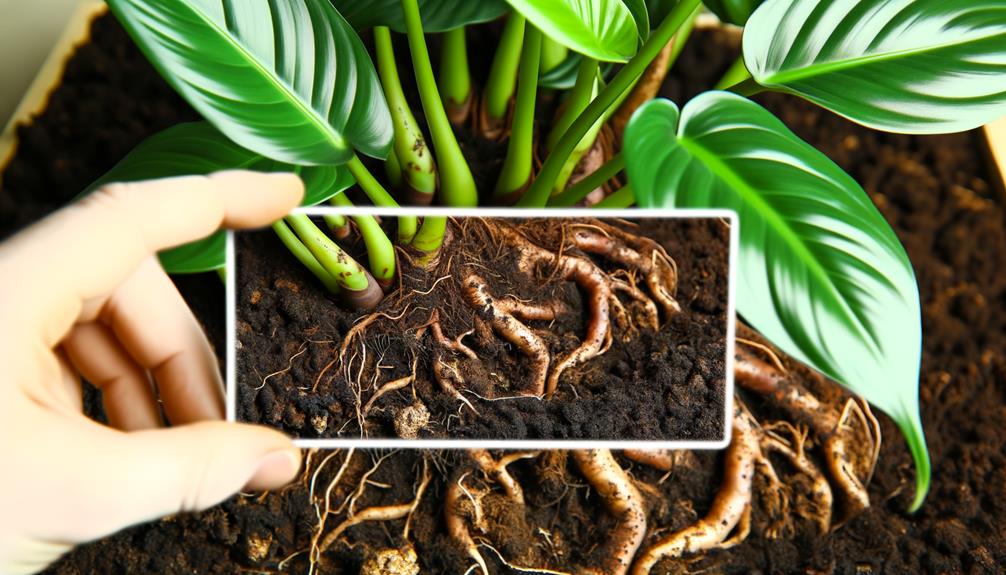
Ideal soil composition and fertilization practices are crucial for the healthy growth and distinct characteristics of Philodendron Atabapoense and Spiritus Sancti. Both species require well-draining, aerated substrates, yet their needs display subtle differences.
Philodendron Atabapoense thrives in a mix incorporating:
- Orchid bark – Enhances aeration and drainage.
- Perlite – Improves soil structure and prevents compaction.
- Peat moss – Retains moisture while maintaining acidity.
In contrast, Spiritus Sancti benefits from:
- Coconut coir – Promotes moisture retention without waterlogging.
- Horticultural charcoal – Purifies the soil and prevents root diseases.
- Leaf mold – Adds organic matter and beneficial microbes.
Fertilization should be balanced; use a slow-release, balanced 20-20-20 fertilizer quarterly, ensuring micronutrient supplementation for optimum growth.
Propagation Methods
Propagation of Philodendron Atabapoense and Spiritus Sancti can be achieved through stem cuttings, air layering, or tissue culture. Each method offers distinct advantages and challenges based on the species’ specific growth characteristics.
Stem cuttings, a common technique, involve cutting a section of the stem with nodes and placing it in a growth medium.
Air layering requires wounding a part of the stem, applying rooting hormone, and wrapping it in moist sphagnum moss until roots develop.
Tissue culture, though technically demanding, allows for mass propagation under sterile conditions and genetic uniformity.
Philodendron Spiritus Sancti, being rarer and more delicate, often benefits more from tissue culture to assure higher success rates. In contrast, Philodendron Atabapoense adapts well to stem cutting and air layering.
Conclusion
In summation, the Philodendron atabapoense and Philodendron spiritus sancti emerge as botanical marvels, each distinctly characterized by their origins, leaf morphology, and ecological requirements.
The atabapoense, with its elongated, lanceolate leaves, contrasts strikingly with the spiritus sancti’s intricate, undulating foliage.
Both exhibit unique growth patterns and specific environmental dependencies. Through comparative analysis, these philodendrons are revealed as vivid exemplars of the diversity within their genus, each contributing uniquely to the tapestry of tropical flora.

